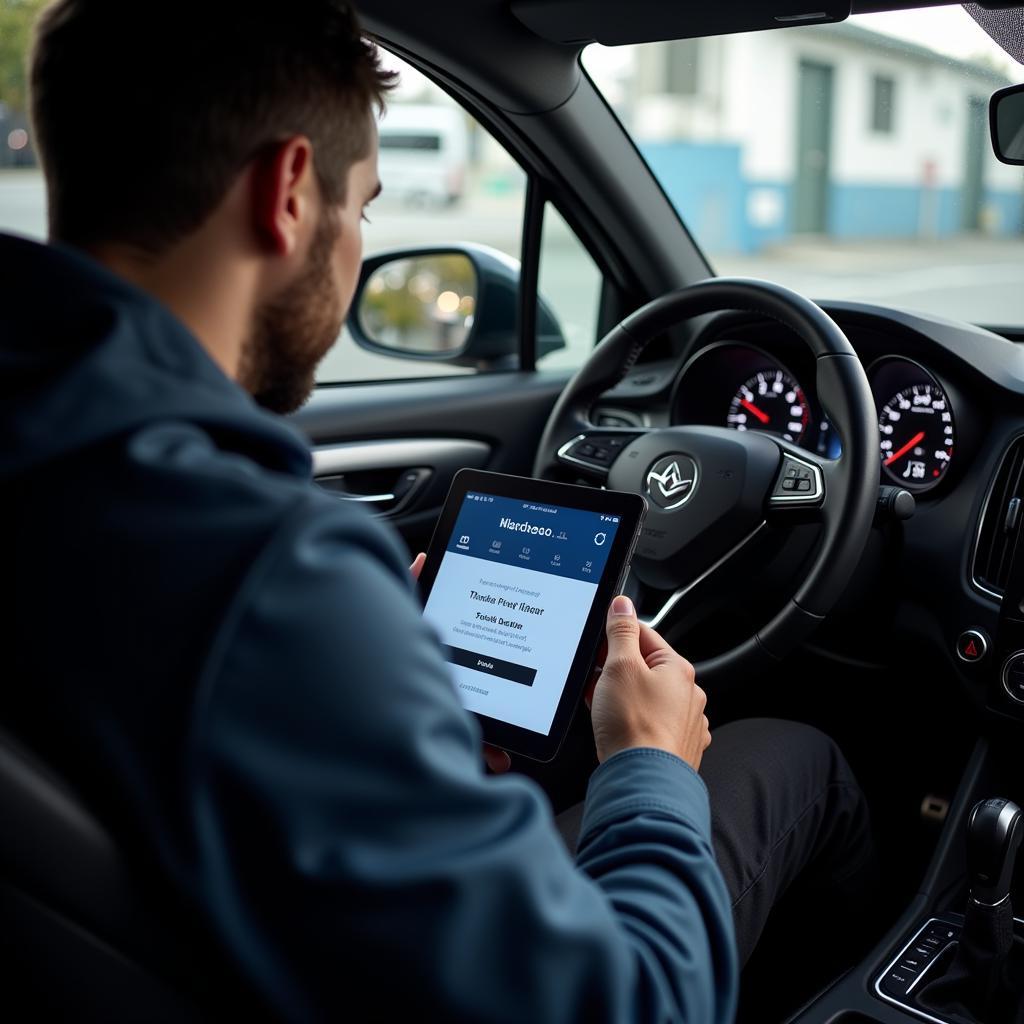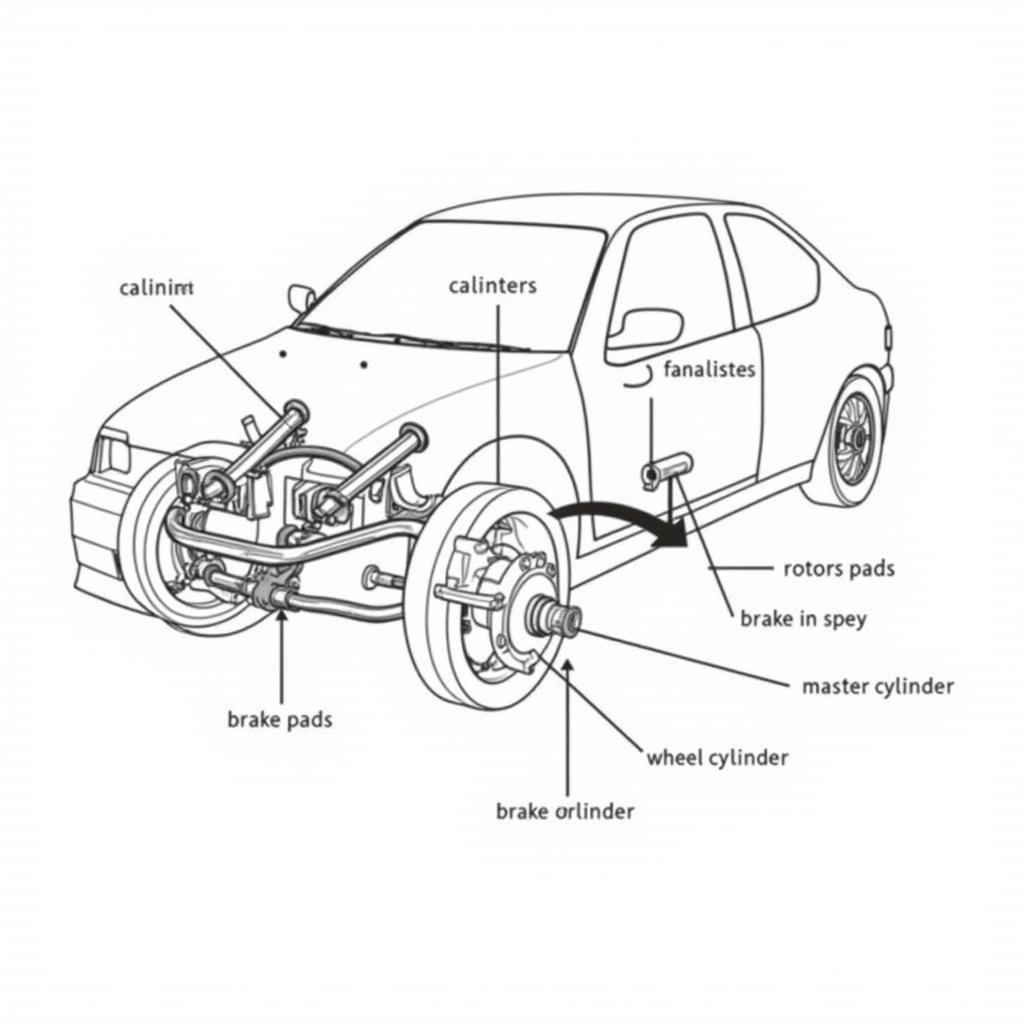A “brake fluid warning” light flashing on your Chevy Cobalt’s dashboard can be alarming. This signal is your car’s way of saying there’s a problem with the braking system that needs immediate attention. Ignoring it could lead to serious consequences, compromising your safety on the road.
This comprehensive guide will walk you through the common causes of the “cobalt brake fluid warning” light, how to diagnose the problem, and the necessary steps to address it.
Understanding Your Chevy Cobalt’s Brake System and Warning Lights
Your Cobalt’s brake system is hydraulic, meaning it uses brake fluid to transmit force from the brake pedal to the wheels, ultimately stopping your vehicle. A critical component is the brake fluid reservoir, which stores the fluid and ensures it’s at the correct level for optimal performance.
The “brake fluid warning” light, often a red circle with an exclamation mark inside, typically indicates low brake fluid levels. However, it can also point to other issues like:
- Worn brake pads: As brake pads wear down, the calipers need to extend further to engage the brake rotor. This action draws more brake fluid from the reservoir. If your pads are severely worn, the reservoir may become depleted enough to trigger the warning light.
- Brake fluid leak: A leak in your brake lines, calipers, or wheel cylinders can cause a significant drop in brake fluid, triggering the warning light.
- Faulty brake sensor: A malfunctioning brake fluid level sensor can send false signals, causing the warning light to illuminate even when the fluid level is adequate.
Diagnosing the Problem: Why is Your Brake Fluid Warning Light On?
Before taking any action, it’s crucial to determine the root cause of the “cobalt brake fluid warning” light. Here’s a step-by-step guide:
- Check Your Owner’s Manual: Your Cobalt’s owner’s manual is your best resource for information specific to your car model. It will provide instructions on locating the brake fluid reservoir and checking the fluid level.
- Inspect the Brake Fluid Level: With the engine off, locate the brake fluid reservoir. It’s typically a translucent plastic container with a black cap, situated near the firewall on the driver’s side. Check the fluid level against the “MIN” and “MAX” markings on the reservoir.
- Inspect for Leaks: Carefully examine the area around the brake fluid reservoir, brake lines, and each wheel well for signs of leaks. Look for wet spots, drips, or puddles of brake fluid, which is typically clear or slightly yellowish.
What To Do If Your Cobalt Brake Fluid Warning Light is On
Depending on the cause of the warning light, you have several options:
1. Low Brake Fluid Level (No Visible Leak):
- Add Brake Fluid: If the brake fluid level is low but there are no visible leaks, you can carefully add DOT 3 or DOT 4 brake fluid (check your owner’s manual for the recommended type) to the reservoir, bringing it to the “MAX” line.
- Schedule a Brake Inspection: It’s crucial to determine why the brake fluid level was low in the first place. Even if you’ve temporarily resolved the issue, schedule a brake inspection with a qualified mechanic to rule out any underlying problems.
2. Brake Fluid Leak:
- Do Not Drive Your Car: Driving with a brake fluid leak is incredibly dangerous. The leaking fluid will continue to deplete the system, leading to brake failure.
- Contact a Mechanic Immediately: Call a tow truck and have your Cobalt transported to a trusted mechanic to diagnose and repair the leak.
3. Worn Brake Pads:
- Schedule a Brake Pad Replacement: Worn brake pads not only contribute to low brake fluid levels but also compromise your ability to stop safely. Schedule a brake pad replacement as soon as possible.
 Mechanic Inspecting Brake Fluid Leak
Mechanic Inspecting Brake Fluid Leak
Remote Diagnostics and Software Solutions for Brake Issues
In some cases, the “cobalt brake fluid warning” light may be related to software or electronic issues within the braking system. Advanced remote diagnostics and programming services can help identify and resolve these problems:
- Remote Scanning and Diagnostics: Qualified technicians can remotely connect to your vehicle’s onboard computer system to retrieve diagnostic trouble codes (DTCs). These codes provide valuable insights into the potential causes of the warning light, helping pinpoint the issue accurately.
- Software Updates and Reprogramming: Occasionally, software glitches or outdated modules within the braking system can trigger warning lights. Remote programming services allow technicians to install the latest software updates, ensuring your vehicle’s systems are functioning correctly.
Expert Insight:
“Modern vehicles like the Chevy Cobalt heavily rely on electronics and software for various functions, including braking. While low brake fluid or physical damage are common causes for the warning light, don’t discount the possibility of software-related issues,” says John Miller, a certified automotive electrician with over 15 years of experience in diagnostics and remote programming. “Seeking professional remote diagnostics can provide a precise understanding of the problem, saving you time and potential headaches.”
Preventing Future Brake Issues in Your Chevy Cobalt
Taking preventative measures can help avoid encountering the “cobalt brake fluid warning” light and ensure your braking system remains in optimal condition:
- Regular Brake Fluid Flushes: Consult your owner’s manual for the recommended brake fluid flush intervals. Over time, brake fluid absorbs moisture, reducing its effectiveness and potentially damaging brake components. Regular flushing prevents these issues.
- Routine Brake Inspections: Schedule annual brake inspections, or more frequently if you drive in harsh conditions or frequently engage in heavy braking. A mechanic can identify potential problems early on, preventing costly repairs and ensuring your safety.
- Pay Attention to Warning Signs: Be aware of any changes in your braking performance, such as a spongy brake pedal, unusual noises, or a longer stopping distance. Address these issues promptly to prevent more significant problems.
Conclusion: Prioritize Your Safety – Address Brake Issues Promptly
The “cobalt brake fluid warning” light is a crucial safety indicator that should never be ignored. By understanding its potential causes and taking appropriate action, you can ensure your Chevy Cobalt’s braking system remains reliable and safe. Remember, regular maintenance and timely repairs are vital for optimal brake performance and your safety on the road. If you’re ever unsure about diagnosing or addressing a brake issue, consult a qualified mechanic immediately.



